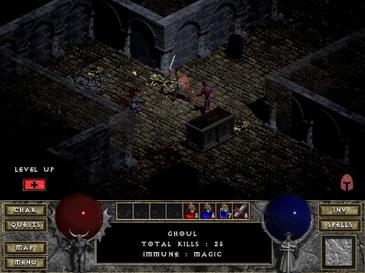Mephisto and Diablo have been defeated by the destruction of their soulstones in the Hellforge. The epilogue to Diablo II reveals the fate of their third brother Baal, the Lord of Destruction. After tricking Marius--the narrator of the Diablo II saga--into surrendering the last soulstone after pretending to be the Archangel Tyrael, Baal proceeded to the Barbarian Highlands, aiming to corrupt the all-powerful Worldstone located at the Summit of Mount Arreat. Thus begins Diablo II: Lord of Destruction.
In addition to extension of the plot and a new fifth act that takes place in the Barbarian Highlands, the expansion pack to Diablo II contains many new enhancements to the original game. Two new character classes--the druid and the assassin--are introduced. Like the first five original character classes, both are playable in the first four acts of the game. New items, a bigger stash and items unique to each character class are also added in the expansion.


Like the first two games before it, LOD as players refer to it, received mainly positive feedback from the gaming community. Save for Neverwinter Nights and Sims, I believe I have spent more hours on this than any other game I have ever played in my entire life.
Tuesday, March 11, 2008
Remembering Diablo II: Lord of Destruction
Tuesday, March 4, 2008
Remembering Diablo II
Gamers worldwide knew that although Diablo was indeed revolutionary and way ahead of its time, the game was just too short. It was also becoming monotonous towards the middle and so much more towards the end. In response to all the reactions from the millions of Diablo fans worldwide, Blizzard North released the sequel to the 1996 Game of the Year. And thus, Diablo II was born.
The developers were correct in releasing the sequel. Diablo II was a runaway success for Blizzard. Various gaming organizations awarded Diablo II with top honors, rating the game with some of the highest scores a game could be given at the time of its release. It was also awarded in the Guinness Book of World Records "2000 edition" for being the fastest selling computer game ever sold. It was also 2001's Game of the Year.
When I first played Diablo II, I looked for the three character classes that I was accustomed to in the prequel. They were no longer there. Instead, five new classes, all unique from the rest, were introduced in the game. The five character classes, similar to the previous game, had different preset abilities. However in the sequel, they now too, had different skill sets, so it was now impossible to learn a particular spell or skill unless it was inherent to the character.
I wanted to try all the five characters, but I chose a specific one to try out the game first. Of the five--amazon, barbarian, sorceress, necromancer and paladin--I chose the holy warrior as my first character. He was the closest equivalent to the warrior hero I so admired in Diablo. His only difference was that he was, well, holy. The cinematics later narrated the fate of the warrior hero. He was defiled, brought about by an internal conflict within himself. Why had he slain Prince Albrecht? Was there justice in killing Diablo while sacrificing the body of the beloved young prince? The confusion went on in his head, unknowingly bringing his humanity to a halt. He had become the enemy he thought he had brought an end. He had become Diablo, the Lord of Terror.
And so the story continues...

I think I have played this game more than ten times since it was released in 2001. Although I first used the paladin in fighting the demons in this game, I have grown to love the skillfulness of the sorceress more than any other character class. Her mastery of elemental spells enables her to fight afar, unlike the close-range melee fighter who is the paladin. My brother thinks otherwise. He loves his paladin character more than any of the other characters I have used in the game.
The objective of all the players in the game is to defeat Diablo. Aside from him, other demons must be subdued too. The list includes Andariel, the Maiden of Anguish; Duriel, the Lord of Pain; and Diablo's brother Mephisto, the Lord of Hate. Other smaller quests are available for the players. Rewards vary from the addition of skill points and learning a skill of the player's choice to acquisition of rare, magical and unique items which can provide additional protection against the hell-spawned beasts and demons to beat.
Players would soon realize that the end of terror would not really be the end of it all. The last of the three prime evils, Baal, the Lord of Destruction, has escaped. And, as if foreboding another sequel, the epilogue leaves the player hanging. What would be Baal's next moves? Would Baal succeed in letting out evil and destruction into the world? Thankfully, Blizzard has released an expansion pack to Diablo II called Lord of Destruction. But, that is again, another story.
Remembering Diablo
My favorite RPG will forever be Diablo. Back in the late 90s when the PC game was released, I spent countless hours--even into the wee hours--working on the brain-draining quests. Naturally, I would frequently doze off in class, but that's another story.
There were three character classes to choose from: warrior, rogue and sorcerer. I chose the warrior because I found his preset attributes to my liking. Plus, he donned a sword and a shield. He reminded me of the heroes in action-fantasy movies I watched. Also, I kinda liked the action involved in meleé fighting.
Diablo received the most coveted Game of the Year award from GameSpot, also awarding the game an astounding 9.6 rating (out of 10), the highest ever to be given for a game, to date.






